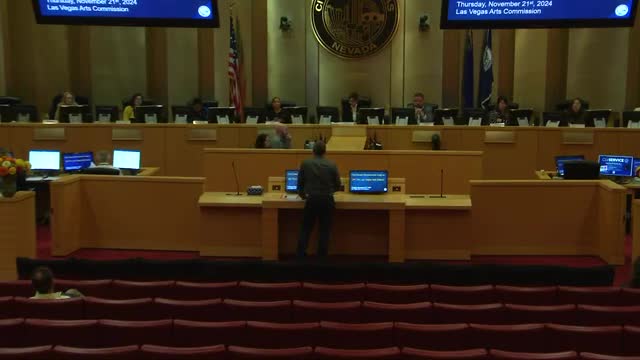Las Vegas Arts District Plans Bold Revitalization Strategy
November 21, 2024 | Las Vegas , Clark County, Nevada
This article was created by AI summarizing key points discussed. AI makes mistakes, so for full details and context, please refer to the video of the full meeting. Please report any errors so we can fix them. Report an error »

During a recent government meeting, officials discussed the future of the Arts District in Las Vegas, emphasizing its historical significance and the need for strategic development to preserve its creative essence. The Arts District, which emerged in the early 1990s around key venues like the Enigma Cafe and the Arts Factory, played a crucial role in revitalizing downtown Las Vegas, particularly during the economic downturn from 2005 to 2010.
The meeting highlighted the Vision 2045 Downtown Master Plan, which aims to enhance connectivity, attract residents, and improve access to cultural resources. The Arts District is recognized as a vital component of this plan, with officials noting its current success in food and beverage but expressing concern over the potential dilution of its artistic identity if proactive measures are not taken.
Key proposals discussed included the implementation of a form-based code for zoning, which would prioritize building design and its interaction with public spaces over traditional zoning classifications. This approach aims to ensure that new developments contribute to the artistic landscape of the district, including requirements for public art installations.
Officials also outlined plans to expand the Arts District's boundaries to better align with community perceptions and needs, particularly in terms of affordable housing for artists. Partnerships with organizations like Art Space are being pursued to facilitate this development.
A significant aspect of the discussion was the introduction of a public art requirement for redevelopment projects, mandating that a percentage of development costs be allocated to public art. This initiative aims to foster collaboration with local artists and ensure that new developments enhance the district's cultural fabric.
Commissioners raised points about the balance between visual and performing arts, suggesting that both should be integrated into the district's development strategy. The importance of allowing for the rotation of art installations was also emphasized, ensuring that the district remains dynamic and engaging.
The timeline for these initiatives includes the drafting of a new regulating plan by December, with hopes for adoption by mid-2025. The meeting underscored a commitment to maintaining the Arts District as a vibrant hub for creativity and community engagement, while navigating the challenges of urban development.
The meeting highlighted the Vision 2045 Downtown Master Plan, which aims to enhance connectivity, attract residents, and improve access to cultural resources. The Arts District is recognized as a vital component of this plan, with officials noting its current success in food and beverage but expressing concern over the potential dilution of its artistic identity if proactive measures are not taken.
Key proposals discussed included the implementation of a form-based code for zoning, which would prioritize building design and its interaction with public spaces over traditional zoning classifications. This approach aims to ensure that new developments contribute to the artistic landscape of the district, including requirements for public art installations.
Officials also outlined plans to expand the Arts District's boundaries to better align with community perceptions and needs, particularly in terms of affordable housing for artists. Partnerships with organizations like Art Space are being pursued to facilitate this development.
A significant aspect of the discussion was the introduction of a public art requirement for redevelopment projects, mandating that a percentage of development costs be allocated to public art. This initiative aims to foster collaboration with local artists and ensure that new developments enhance the district's cultural fabric.
Commissioners raised points about the balance between visual and performing arts, suggesting that both should be integrated into the district's development strategy. The importance of allowing for the rotation of art installations was also emphasized, ensuring that the district remains dynamic and engaging.
The timeline for these initiatives includes the drafting of a new regulating plan by December, with hopes for adoption by mid-2025. The meeting underscored a commitment to maintaining the Arts District as a vibrant hub for creativity and community engagement, while navigating the challenges of urban development.
View full meeting
This article is based on a recent meeting—watch the full video and explore the complete transcript for deeper insights into the discussion.
View full meeting